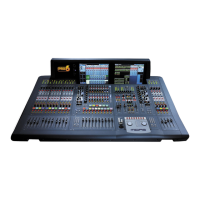8
9
6
4
7
D zone
1
2
3
4
10
5
9
8
7
11
1 ON switch, enables gate in the signal
path. When switched off, gate is bypassed.
(Both the comp and gate switches can be on
at the same time.)
2 To aid set up, the gate has a side chain
listen that sends the side chain onto a solo bus.
This side chain listen LED indicator illuminates
to warn you that soloed material is from the
side chain, and not the main channel. For
information on the side chain, see “Side chain”
on page 273.
3 Quick access button, selects the local
input channel and assigns the all of the gate
controls to the input channel strip (and the
channel’s gate processing area to the GUI
channel strip) for near instant access.
4 threshold control knob, sets signal level
at which gate opens. Range is from -50dB to
+25dB.
5 hold control knob, minimises chattering
in conjunction with internal hysteresis. Once
the signal is detected as below threshold, this
defines a waiting period before the gate starts
to close. Range is from -0.005s to 2.000s
(seconds).
6 Up/down select buttons, for swapping
dynamic section control from compressor to
gate, and vice versa.
7 Gate ratio/range/[range] control knob,
adjusts amount of gain reduction applied to the
signal below threshold. Controls the maximum
gain reduction that is possible. Range is from
minus infinity (-∞) to zero.
8 attack control knob, adjusts time taken
for gate to open after an over-threshold signal.
Range is from 0.02ms to 20ms (milliseconds).
9 release control knob, adjusts time taken
for gate to close after programme material falls
back below threshold. Range is from -0.005s
to 2.000s (seconds).
10 Gate graph display. Similar to the
compressor graph (see “Compressor graph” on
page 270), this shows the effects of adjusting
the gate control knobs.
11 Gate meter, mimics the gate meter at the
top of the input channel’s fast strip (see “Input
metering” on page 260).
5

